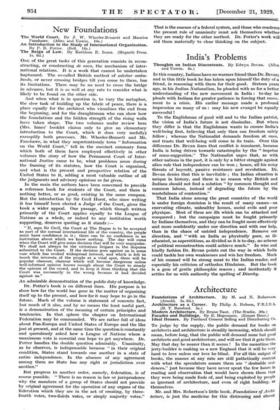Architecture
Foundations of Architecture. By M. and N. Robertson. (Arnold. 3s. fid.) To judge by the supply, the public demand for books on architects and architecture is steadily increasing, which should mean, before long, that the public will demand none but good architects and good architecture, and will see that it gets them. May that day be nearer than it seems ! In the meantime the jerry-builder is making us a new England that it will be very hard to love unless our love be blind. For all this output of books, the masses at any rate are still pathetically content with what the speculators assure them are " desirable resi- dences," just because they have never spent the few hours in reading and observation that would have shown them that they were being made fools of, and being exploited by people as ignorant of architecture, and even of right building, as themselves.
Mr. and Mrs. Robertson's little book, Foundations of Archi- tecture, is just the medicine for this distressing and almost
universal complaint. Professor Reilly says in his intro- duction :—
" They treat architecture as a living thing answering the everyday problems of life with no bombast or mystery about it. They explain the qualities of a brick, a wall, or a roof as a motor engineer might explain a carburettor or a magneto to &beginner. This, I am convinced is the right way. A child could read Foundations of Architecture and find it interesting as well as a grown-up person. That, I think, is a good test if architecture is as alive to-day as one likes to believe."
Mr. Philip A. Robson's small volume declares its limited appeal in its title with commendable honesty—it is called Architecture as a Career: A Manual for Aspirants and Students of Either Sex. The author accomplishes what he set out to do both clearly and fully, embellishing the work, that he probably and rightly felt to be a trifle dry, with a number of engaging plates of no particular relevance. Not so the hundreds of photographs in Herr Bruno Taut's compendious book, Modern Architecture, where his dramatic pictures really do illustrate his theme. And very unsettling stuff it is, this mass meeting of all that are most notably " modern " of the world's buildings from Moscow to Montreal—the austere champions of the new aesthetic with this device on their revo- lutionary banners : " Architecture is the convergence of purpose and material."
Being essentially multi-cellular and collectivist in its fullest expression, the New Architecture has not found a favourable soil in England, where we have not got much further than where we began—with Joseph Paxton's Crystal Palace. But Herr Taut wrote his book in England and he is very polite to his hosts—more polite than we deserve. He does, however, make it clear that Holland, Russia and Ger- many are the places in which to see the new movement at its best, some of the most distinguished German work being his own. His book is a valuable one and will help to give us the new eyes that we shall surely need for a new age.
Only slightly does Herr Hegemann's Facades of Buildings overlap Herr Taut's book, for though it ends with post-War Hamburg, it begins with Imperial Rome, presenting a vast variety of street architecture by some five hundred plates in the course of that journey through time and space. It is truly a remarkable picture-book of grouped (if not regimented) urban architecture from all over Europe, in which England shows up well for past performances, and Germany, Scandi- navia and Holland for what is new. Especially commendable are the "Reconstructions of houses in East Prussia damaged by the War." One wishes that the Germans might have sent 'not merely marks and materials to France's devastated areas, but architects as well !
Ideal Homes is really a commercial propagandist publica- tion by the Red Triangle Cement Organization. It is adver- tising at its best and most intelligent, for it reproduces forty-. eight of the seven hundred plans sent in for its architects' competition selected as best by the assessors. The subject set was a £1,500 house in concrete, and though the premiated design is thoroughly traditional in flavour, there is no lack of modern chic about the generality. It is surprising that a firm that can advertise so well should still advertise also so very badly. There are many architects who must hesitate to specify a cement that stoops to advertise itself on roadside bill-boards as though it were a liver-pill or a whisky.
CtouGH Wir..L.Leats-ELLis.



































 Previous page
Previous page